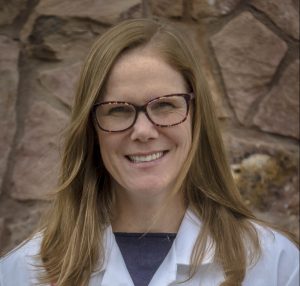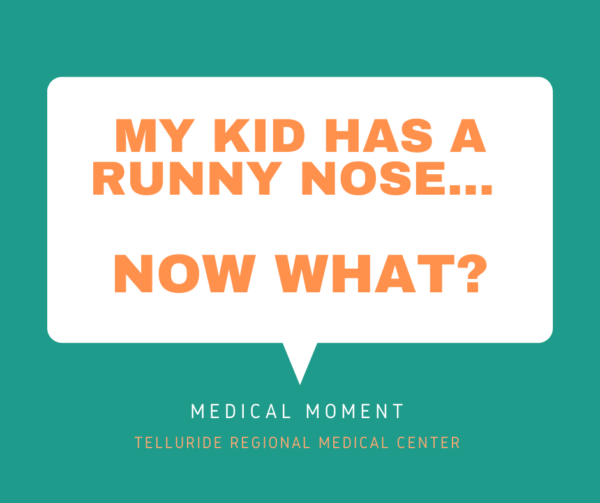
02 Oct Medical Moment: My Kid Has A Runny Nose…Now What?
To make an appointment for a PCR diagnostic COVID-19 test at the Telluride Medical Center visit tellmed.org/testingand get step-by-step instructions.
Go here for more Medical Moments.

For Wilder, a sixth grade Telluride Intermediate School student who competes on the cross-country team, it started with a headache.
The first thing Wilder’s mom did was take a moment to remember the “Before Times” when a mild headache was a complete nonevent.
But Dr. Sharon Grundy, primary care provider at the Telluride Regional Medical Center and Wilder’s mom, also knew this day would come.
“Same as it ever was: kids get sick.”
And so she and her husband, Tor Anderson, took their son’s temperature, noted the time and let the school know they’d be keeping him home from school the following day.
Per the COVID-19 Symptom Flowchart — a document Dr. Grundy helped create along with her peers at the San Miguel County Public Health and Uncompahgre Medical Center to help guide parents with daily health screenings — if Wilder is symptom free the following day, a Friday, he can return to school on Monday. But if in 24 hours he has the same or more symptoms, there’s a whole other protocol she’ll need to enact.
Dr. Grundy, who is also a Public Health Officer, must now navigate the very same rules and steps she helped to create.
“I know what I have to do to protect my son, husband, mother, the people I work with and my community. But I’d be lying if I didn’t also say it’s massively inconvenient.”
Like many other parents will do this school year, she reviewed the COVID-19 Symptom Flowchart for answers to questions like how long Wilder will need to stay home, who else needs to isolate, and when or if he should be tested for coronavirus.
And that’s only the start.
Dr. Diana Koelliker — also a parent of a school-aged child and another of the architects of the local medical center’s response to COVID-19 — says patience is the watchword.
“Parents need to be patient and see if their child’s symptoms resolve within 24 hours before rushing in to be seen,” she said.
San Miguel Public health requires that students are tested when symptoms last longer than 24 hours, and that children who are exposed to a positive case in their classroom also be tested.
Dr. Koelliker notes that best practice is to wait 5-7 days after contact with a known positive to get tested if asymptomatic.
“While difficult, we also all need to be patient as we wait for the results of the test.”
Specifically, Dr. Koelliker is calling for the kind of patience required to physically stay at home to not potentially expose other children or families while waiting for a test to come back.
Which is where Dr. Grundy and her family found themselves when Wilder, the next day, woke up without a headache, but instead with a runny nose and later congestion.
“With all the smoke in the region, I found myself wanting to downplay myself out of the situation,” admitted Dr. Grundy. “There’s a hundred reasons he could have a runny nose and they are not all coronavirus.”
Nonetheless, staying the course, Dr. Grundy’s entire household, which includes her mother and husband, began practicing isolation as detailed in the Symptom Flowchart. Dr. Christine Mahoney — Wilder’s healthcare provider — was contacted and a COVID-19 test was scheduled.
Another opportunity to practice patience comes even after results are delivered. “Even with a negative result, Wilder will need to continue to isolate and attend school remotely until 10 days from onset of symptoms,” said Dr. Koelliker.
Wilder’s parents however, so long as they remain asymptomatic, can return to work if his test is negative. If he receives a positive test result, there’s yet another series of steps that will include notifying close contacts and testing the rest of the family.
“This fall and this winter is going to be tough on everyone,” said Dr. Koelliker. “Parents need to be patient with the protocols, school administrators and healthcare workers too.”
Dr. Grundy suggests that everyone have a plan:
“Every household with kids will likely encounter an experience like this. It’s important to know what you’ll need to do to stay home, how your employer will accommodate you and how you’ll get supplies to allow you to isolate.”
In anticipation of situations like this the federal government passed the Families First Coronavirus Response Act which requires certain employers to provide employees with paid sick leave and expanded family and medical leave for reasons related to COVID-19. Tri-County Health Network also offers support for families during this time.
“Our family is so grateful that our schools are open, and we understand that privilege also comes with trade-offs, like having to be both super vigilant and very flexible. There’s no denying this is going to be especially hard for parents who can’t work from home and single parents,” said Dr. Grundy.
By that Tuesday evening, Wilder’s symptoms had cleared up entirely. His negative test results were reported back to the family on Wednesday and he returned to school only after the 10 days had passed since his headache.
“Outside of all the steps you can take to protect yourself from the virus, patience and advance planning is the best advice we have,” said Dr. Grundy.


Sorry, the comment form is closed at this time.